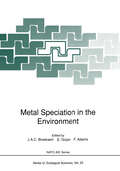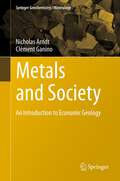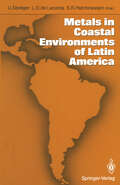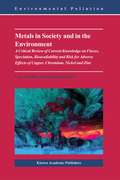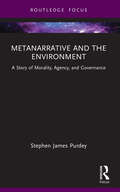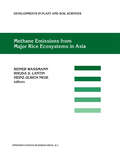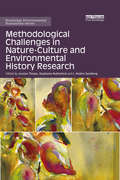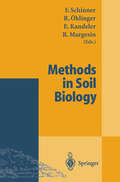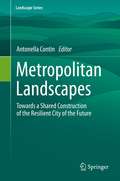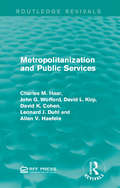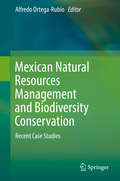- Table View
- List View
Metagovernance for Sustainability: A Framework for Implementing the Sustainable Development Goals (Routledge Studies in Sustainable Development)
by Louis MeulemanThe 17 Sustainable Development Goals (SDGs) which were adopted by the United Nations in September 2015 are universally applicable in all 193 UN Member States and connect the big challenges of our time, such as hunger and poverty, climate change, health in an urbanised environment, sustainable energy, mobility, economic development and environmental degradation. Sustainability has the characteristics of a ‘wicked problem’, for which there are no one-size-fits-all solutions. This book tests the hypothesis that the implementation of sustainable development, and in particular the 2015 SDGs, requires tailor-made metagovernance or ‘governance of governance’. This is necessary to develop effective governance and high quality and inclusive public administration and to foster policy and institutional coherence to support implementing the SDGs. Based on the growing literature on governance and metagovernance, and taking into account the specificities of societal factors such as different values and traditions in different countries, the book presents a framework for the design and management of SDG implementation. It shows how hierarchical, network and market governance styles can be combined and how governance failure can be prevented or dealt with. The book presents an overview of fifty ‘shades of governance’ which differ for each governance style, and a sketch of a concrete method to apply sustainability metagovernance. Metagovernance for Sustainability is relevant to academic and practitioner fields across many disciplines and problem areas. It will be of particular interest to scholars, students and policy-makers studying Sustainable Development, Governance and Metagovernance, Public Management and Capacity Building.
Metal Removal and Recovery from Mining Wastewater and E-waste Leachate (IHE Delft PhD Thesis Series)
by Suthee JanyasuthiwongMetal contamination in the environment is a persisting global issue. The metal reservoirs in the earth have declined due to society’s needs and due to uncontrolled mining activities. Therefore, the idea to recover metals from waste streams has emerged. In this thesis, cost competitive technologies such as adsorption using agro-wastes and precipitation using an inverse fluidized bed (IFB) reactor were investigated, with special emphasis on the recovery of base metals. Groundnut shell showed good potential for metal (Cu, Pb and Zn) removal. From artificial neural network modeling, the performance of the sulfate reducing bacteria (SRB) was found to be strongly pH dependent; the removal efficiency of Cu and Zn in the IFB at pH 5.0 was >97%. Electronic waste is a good candidate as secondary metal resource. The recovery of Cu from computer printed circuited boards (PCBs) using biogenic sulfide precipitation was investigated as well. Using this technology, Cu could be recovered at ~0.48 g Cu/g PCBs.
Metal Removal and Recovery from Mining Wastewater and E-waste Leachate (IHE Delft PhD Thesis Series)
by Suthee JanyasuthiwongMetal contamination in the environment is a persisting global issue. The metal reservoirs in the earth have declined due to society’s needs and due to uncontrolled mining activities. Therefore, the idea to recover metals from waste streams has emerged. In this thesis, cost competitive technologies such as adsorption using agro-wastes and precipitation using an inverse fluidized bed (IFB) reactor were investigated, with special emphasis on the recovery of base metals. Groundnut shell showed good potential for metal (Cu, Pb and Zn) removal. From artificial neural network modeling, the performance of the sulfate reducing bacteria (SRB) was found to be strongly pH dependent; the removal efficiency of Cu and Zn in the IFB at pH 5.0 was >97%. Electronic waste is a good candidate as secondary metal resource. The recovery of Cu from computer printed circuited boards (PCBs) using biogenic sulfide precipitation was investigated as well. Using this technology, Cu could be recovered at ~0.48 g Cu/g PCBs.
Metal Speciation in the Environment (Nato ASI Subseries G: #23)
by J. A. C. Broekaert S. Gücer F. AdamsProceedings of the NATO Advanced Study Institute on Metal Speciation in the Environmental held in Cesme, Turkey, October 9-20, 1989
Metallic Mineral Exploration: An Economic Analysis (Routledge Revivals)
by Roderick G. EggertHow has exploration for minerals evolved in recent years? Is it as productive an activity as it once was? Why have changes occurred? Roderick G. Eggert explores these and other questions about the complex set of circumstances surrounding metallic mineral exploration. Originally published in 1987, Eggert documents trends in the level and the distribution of expenditures by mining companies for metallic mineral exploration and examines a number of factors that may be responsible for these trends. This significant study serves as a handy introduction to the subject for students interested in environmental studies, natural resources, and economics.
Metallic Mineral Exploration: An Economic Analysis (Routledge Revivals)
by Roderick G. EggertHow has exploration for minerals evolved in recent years? Is it as productive an activity as it once was? Why have changes occurred? Roderick G. Eggert explores these and other questions about the complex set of circumstances surrounding metallic mineral exploration. Originally published in 1987, Eggert documents trends in the level and the distribution of expenditures by mining companies for metallic mineral exploration and examines a number of factors that may be responsible for these trends. This significant study serves as a handy introduction to the subject for students interested in environmental studies, natural resources, and economics.
Metals and Society: An Introduction to Economic Geology (Springer Geochemistry/Mineralogy #2)
by Nicholas Arndt Clément GaninoIn the second edition Steve Kesler (University of Michigan) has been added as an author to rewrite some chapters. The motivation for this revised edition is to more intensively address economic issues that surround the exploitation of mineral resources. This emphasis gives the book a unique character. With these sections Metals and Society deals with issues that pervade much of current science reporting – the rate of exploitation of natural resources, the question of when or if these resources will be exhausted, the pollution and social disturbance that accompanies mining, the compromises and challenges that arise from the explosion of demand from China, India and other rapidly developing countries, and the moral issues that surround mining of metals in lesser developed countries for consumption in the “first-world” countries. With its dual character, the book will be useful as an introductory text for students in the earth sciences and a reference volume for students, teachers and researchers of geography, economics and the social sciences.
Metals in Coastal Environments of Latin America
by S. R. Patchineelam Luiz DrudeLacerda UlrichSeeligerFor the first time a state-of-the-art of present metal pollution along the coastline of Latin America is provided. This collection of papers from a conference held in August 1986 in Rio de Janeiro, Brazil is designed to inform readers of recent advances in an important, interdisciplinary field. Primary focus is on: - Metal Surveys, Metals in Sediments, Metals in Biota, Metal Transport and Cycles, Metal Monitoring. A final chapter combines conclusion, outlook and recommendations of how to master the critical situation of metal concentrations in coastal environments of Latin America. This book fills a long-standing gap in the literature and will be of prime interest to researchers, students and professionals in geology, biology and chemistry.
Metals in Society and in the Environment: A Critical Review of Current Knowledge on Fluxes, Speciation, Bioavailability and Risk for Adverse Effects of Copper, Chromium, Nickel and Zinc (Environmental Pollution #8)
by Lars Landner Rudolf ReutherThis book presents new results on metal fluxes from society to the environment, on metal speciation in water, soil and sediment, and its mobility, biological uptake and toxicity. New approaches, like the Acid Volatile Sulphide (AVS) concept to predict metal bioavailability in sediments, and the Biotic Ligand Model to calculate the toxicity of metals to aquatic organisms, are critically evaluated, with a focus on copper, nickel, zinc, and, chromium.
Metanarrative and the Environment: A Story of Morality, Agency, and Governance (Routledge Research in Environmental Policy and Politics)
by Stephen James PurdeyTo meet the challenge of global environmental degradation activists have tackled clear and concrete problems such as carbon emissions and climate change, the ruination of ecosystems and habitat, the precipitous loss of biodiversity, and many other unhappy consequences of irresponsible human behaviour. However, all such efforts to manually correct the course of history have been dwarfed by the magnitude and heavy forward momentum of modern industrial society. In Metanarrative and the Environment, Stephen James Purdey argues that material approaches to the environmental crisis cannot succeed without the power of a legitimating discourse – a new metanarrative – which fundamentally changes the ideational landscape of human development. Dr. Purdey begins in Part I by establishing the pragmatics of our environmental predicament – its roots and responses to it. He focuses on the concept, definition, and key features of metanarrative, introducing the hegemonic story that now rules the contemporary global mindscape. Part II takes on the moral problematic more directly, encouraging the evolution of a new metanarrative by bringing our potential for agency in the face of danger into sharper relief. Metanarrative and the Environment is multidisciplinary, with a particular emphasis on the creative humanities. It will be of interest to undergraduate and graduate students alike, as well as environmental activists and academics looking for a new way forward.
Metanarrative and the Environment: A Story of Morality, Agency, and Governance (Routledge Research in Environmental Policy and Politics)
by Stephen James PurdeyTo meet the challenge of global environmental degradation activists have tackled clear and concrete problems such as carbon emissions and climate change, the ruination of ecosystems and habitat, the precipitous loss of biodiversity, and many other unhappy consequences of irresponsible human behaviour. However, all such efforts to manually correct the course of history have been dwarfed by the magnitude and heavy forward momentum of modern industrial society. In Metanarrative and the Environment, Stephen James Purdey argues that material approaches to the environmental crisis cannot succeed without the power of a legitimating discourse – a new metanarrative – which fundamentally changes the ideational landscape of human development. Dr. Purdey begins in Part I by establishing the pragmatics of our environmental predicament – its roots and responses to it. He focuses on the concept, definition, and key features of metanarrative, introducing the hegemonic story that now rules the contemporary global mindscape. Part II takes on the moral problematic more directly, encouraging the evolution of a new metanarrative by bringing our potential for agency in the face of danger into sharper relief. Metanarrative and the Environment is multidisciplinary, with a particular emphasis on the creative humanities. It will be of interest to undergraduate and graduate students alike, as well as environmental activists and academics looking for a new way forward.
Meteorologie: Eine interdisziplinäre Einführung in die Physik der Atmosphäre (Springer-Lehrbuch)
by Brigitte KloseDa die Wetterprognose heutzutage vorwiegend mit numerischen Methoden erfolgt, ist die Meteorologie ein teilgebiet der Physik und Chemie der Atmosphäre geworden und wird zunehmend mathematisch behandelt. Um den Studierenden und allen am Wetter Interessierten aber dennoch einen Einblick in den täglich wechselnden Zustand der Atmosphäre zu ermöglichen, wird nach einführenden Betrachtungen zum Aufbau und zur Thermodynamik der Atmosphäre ausführlich auf die meteorologischen Elemente und deren Messmethoden eingegangen. Neben den synoptischen Systemen der mittleren Breiten und Tropen ist das Augenmerk auch auf die allgemeine Zirkulation und die Bildung tropischer Wirbelstürme sowie die damit verbundene Sturmnavigation gerichtet. In der zweiten Auflage ist das Werk umfassend aktualisiert und ergänzt worden.
Meteorologie: Eine interdisziplinäre Einführung in die Physik der Atmosphäre (Springer-Lehrbuch)
by Brigitte KloseDas derzeit umfassendste Meteorologie-Lehrbuch: Die Autorin ermöglicht einen leichten Einstieg in das Thema und dessen Teilgebiete: Aufbau und Thermodynamik der Atmosphäre, meteorologische Elemente und Messmethoden, Satellitenmeteorologie, synoptische Systeme der mittleren Breiten und Tropen, allgemeine Zirkulation, Bildung tropischer Wirbelstürme oder Sturmnavigation. Wetterprognose im Überblick.
Methane Emissions from Major Rice Ecosystems in Asia (Developments in Plant and Soil Sciences #91)
by Reiner Wassmann Rhoda S. Lantin Heinz-Ulrich NeueRice production is affected by changing climate conditions and has the dual role of contributing to global warming through emissions of the greenhouse gas methane. Climate change has been recognized as a major threat to the global environment. Because of insufficient field data, rice-growing countries face a problem when trying to comply with the United Nations Framework Convention on Climate Change stipulations to compile a national inventory of emissions and to explore mitigation options. Given the expected doubling in rice production in Asia, the need to evaluate the interaction between climate change and rice production is critical to forming a sound basis for future directions of technology developments by policy makers, agriculturists, environmentalists, rice producers, and rice consumers. The present book comprises two sections. The first part documents a comprehensive overview of the results achieved from an interregional research effort to quantify methane emission from major rice ecosystems and to identify efficient mitigation options. This research report broadens understanding of the contribution of rice cultivation to methane emissions and clarifies that emissions are relatively low, except in specific rice ecosystems, and that these high emissions could be ameliorated without sacrificing yield. The second section shows results from other projects that investigated the role of rice cultivators in field and laboratory approaches. The findings represent inputs for future modeling approaches in the role of rice cultivators. The expanded database generated by other projects is reflected in modeling efforts.
Methodological Challenges in Nature-Culture and Environmental History Research (Routledge Environmental Humanities)
by Jocelyn Thorpe Stephanie Rutherford L. Anders SandbergThis book examines the challenges and possibilities of conducting cultural environmental history research today. Disciplinary commitments certainly influence the questions scholars ask and the ways they seek out answers, but some methodological challenges go beyond the boundaries of any one discipline. The book examines: how to account for the fact that humans are not the only actors in history yet dominate archival records; how to attend to the non-visual senses when traditional sources offer only a two-dimensional, non-sensory version of the past; how to decolonize research in and beyond the archives; and how effectively to use sources and means of communication made available in the digital age. This book will be a valuable resource for those interested in environmental history and politics, sustainable development and historical geography.
Methodological Challenges in Nature-Culture and Environmental History Research (Routledge Environmental Humanities)
by Jocelyn Thorpe Stephanie Rutherford L. Anders SandbergThis book examines the challenges and possibilities of conducting cultural environmental history research today. Disciplinary commitments certainly influence the questions scholars ask and the ways they seek out answers, but some methodological challenges go beyond the boundaries of any one discipline. The book examines: how to account for the fact that humans are not the only actors in history yet dominate archival records; how to attend to the non-visual senses when traditional sources offer only a two-dimensional, non-sensory version of the past; how to decolonize research in and beyond the archives; and how effectively to use sources and means of communication made available in the digital age. This book will be a valuable resource for those interested in environmental history and politics, sustainable development and historical geography.
Methodology of Uniform Contract Law: The UNIDROIT Principles in International Legal Doctrine and Practice
by Maren HeidemannThis book examines uniform contract law in all relevant areas of legal doctrine and practice, and considers the barriers which exist toward it in modern nation states, namely in the German and English legal systems. The author suggests ways to overcome these obstacles, and develops an autonomous methodology of interpretation of transnational contract principles. The book analyses existing uniform transnational law rules, such as the UNIDROIT Principles of International Commercial Contracts.
Methods for Measuring Greenhouse Gas Balances and Evaluating Mitigation Options in Smallholder Agriculture
by Todd S. Rosenstock Mariana C. Rufino Klaus Butterbach-Bahl Eva Wollenberg Meryl RichardsThis book provides standards and guidelines for quantifying greenhouse gas emissions and removals in smallholder agricultural systems and comparing options for climate change mitigation based on emission reductions and livelihood trade-offs. Globally, agriculture is directly responsible for about 11% of annual greenhouse gas (GHG) emissions and induces an additional 17% through land use change, mostly in developing countries. Farms in the developing countries of sub-Saharan Africa and Asia are predominately managed by smallholders, with 80% of land holdings smaller than ten hectares. However, little to no information exists on greenhouse gas emissions and mitigation potentials in smallholder agriculture. Greenhouse gas measurements in agriculture are expensive, time consuming, and error prone, challenges only exacerbated by the heterogeneity of smallholder systems and landscapes. Concerns over methodological rigor, measurement costs, and the diversity of approaches, coupled with the demand for robust information suggest it is germane for the scientific community to establish standards of measurements for quantifying GHG emissions from smallholder agriculture. Standard guidelines for use by scientists, development organizations will help generate reliable data on emissions baselines and allow rigorous comparisons of mitigation options. The guidelines described in this book, developed by the CGIAR Research Program on Climate Change, Agriculture, and Food Security (CCAFS) and partners, are intended to inform anyone conducting field measurements of agricultural greenhouse gas sources and sinks, especially to develop IPCC Tier 2 emission factors or to compare mitigation options in smallholder systems.
Methods For Monitoring Tiger And Prey Populations
by K. Ullas Karanth James D. NicholsThis book addresses issues of monitoring populations of tigers, ungulate prey species and habitat occupancy, with relevance to similar assessments of large mammal species and general biodiversity. It covers issues of rigorous sampling, modeling, estimation and adaptive management of animal populations using cutting-edge tools, such as camera-traps, genetic identification and Geographic Information Systems (GIS), applied under the modern statistical approach of Bayesian and likelihood-based inference. Of special focus here are animal survey data derived for use under spatial capture-recapture, occupancy, distance sampling, mixture-modeling and connectivity analysees. Because tigers are an icons of global conservation, in last five decades,enormous amounts of commitment and resources have been invested by tiger range countries and the conservation community for saving wild tigers. However, status of the big cat remains precarious. Rigorous monitoring of surviving wild tiger populations continues to be essential for both understanding and recovering wild tigers. However, many tiger monitoring programs lack the necessary rigor to generate the reliable results. While the deployment of technologies, analyses, computing power and human-resource investments in tiger monitoring have greatly progressed in the last couple of decades, a full comprehension of their correct deployment has not kept pace in practice. In this volume, Dr. Ullas Karanth and Dr. James Nichols, world leaders in tiger biology and quantitative ecology, respectively, address this key challenge. The have collaborated with an extraordinary array of 30 scientists with expertise in a range of necessary disciplines - biology and ecology of tigers, prey and habitats; advanced statistical theory and practice; computation and programming; practical field-sampling methods that employ technologies as varied as camera traps, genetic analyses and geographic information systems. The book is a 'tour de force' of cutting-edge methodologies for assessing not just tigers but also other predators and their prey. The 14 chapters here are lucidly presented in a coherent sequence to provide tiger-specific answers to fundamental questions in animal population assessment: why monitor, what to monitor and how to monitor. While highlighting robust methods, the authors also clearly point out those that are in use, but unreliable. The managerial dimension of tiger conservation described here, the task of matching monitoring objectives with skills and resources to integrate tiger conservation under an adaptive framework, also renders this volume useful to wildlife scientists as well as conservationists.
Methods in Environmental Forensics
by Stephen M. MudgeWhile environmental catastrophes can be naturally occurring, often they are the result of criminal intent or malfeasance. Sorting out the details when the land itself is the only witness requires a special set of investigative skills. For accountability to be established, investigators must be able to answer these questions with a measure of scient
Methods in Soil Biology
by Franz Schinner Richard Öhlinger Ellen Kandeler Rosa MargesinIn terrestrial ecosystems, soil microorganisms and soil animals are essential for litter degradation, soil formation and the availability of nutrients and trace elements. The measurement of biological soil parameters allows a rapid evaluation of the effects of chemical and physical influences due to pollutants or soil management.This book introduces a number of well proved methods for the analysis of carbon, nitrogen, phosphorus and sulfur cycles. It focuses further on the determination of the number and biomass of microorganisms, algae and animals in the soil. Particular emphasis is placed on the comprehensible and complete description of the experimental procedures.
Metropolitan Landscapes: Towards a Shared Construction of the Resilient City of the Future (Landscape Series #28)
by Antonella ContinThis edited volume covers many aspects of the Metropolitan Landscapes. Solutions are needed to meet the demand of the citizens of a renewed metropolitan region landscape. It opens up discussions about possible toolkits for strategic actions based on understanding the territory from geographical, urban, architectural, economic, environmental, and public policy perspectives. This book intends to promote the Metropolitan dwelling quality, ensuring human well-being proposing a discussion on the resilient articulation of the interface space among the city's infrastructure, agriculture, and nature.This book results from the Symposium: Metropolitan Landscapes that MSLab of the Politecnico di Milano and ETSA (Sevilla) organized at the IALE 2019 Conference (Milan, July 2019) to manage radical territory transformation with a strategic vision. The widespread growth of urban areas indicates the importance of building resilient sustainable cities capable of minimizing climate-change impact production.The Symposium aimed to discuss the Urban Metabolism approach considering the combination of Landscapes set in a single Metropolitan Ecosystem. Accordingly, new design strategies of transformation, replacement or maintenance can compose Urban-Rural Linkage patterns and a decalage of different landscape contexts. Ecological interest in environmental sustainability, compatibility, and resilience is not tied exclusively to the balance between production and energy consumption. Thus, it is the integration over time and at several scales of the urban and rural landscapes and their inhabitants that nourish the Metropolitan Bioregion.Moreover, the Metropolitan Landscape Book's research hypothesis is the need for a Glossary, strengthening the basis of understanding Metropolitan Landscape's complexity.This book's topic is particularly relevant to Landscape Urbanism, Architecture, Urban disciplines Scholars, Students and Practitioners who want to be connected in a significant way with Metropolitan Discipline’s research field.
Metropolitanization and Public Services (Routledge Revivals)
by Charles M. Haar John G. Wofford David L. Kirp David K. Cohen Leonard J. Duhl Allen V. HaefeleMetropolitanization and Public Services is third in a series on the governance of metropolitan regions which aims to explore the welfare and development of Metropolitan America. Originally published in 1972, this study discusses who decides which essential public services need to be provided within a metropolitan area by looking at political reform as well as presenting ideas on functional efficiency, costs and benefits and the effectiveness of the political process. This title will be of interest to students of environmental studies.
Metropolitanization and Public Services (Routledge Revivals)
by Charles M. Haar John G. Wofford David L. Kirp David K. Cohen Leonard J. Duhl Allen V. HaefeleMetropolitanization and Public Services is third in a series on the governance of metropolitan regions which aims to explore the welfare and development of Metropolitan America. Originally published in 1972, this study discusses who decides which essential public services need to be provided within a metropolitan area by looking at political reform as well as presenting ideas on functional efficiency, costs and benefits and the effectiveness of the political process. This title will be of interest to students of environmental studies.
Mexican Natural Resources Management and Biodiversity Conservation: Recent Case Studies
by Alfredo Ortega-RubioThis book presents valuable and recent lessons learned regarding the links between natural resources management, from a Socio-Ecological perspective, and the biodiversity conservation in Mexico. It address the political and social aspects, as well as the biological and ecological factors, involved in natural resources management and their impacts on biodiversity conservation. It is a useful resource for researchers and professionals around the globe, but especially those in Latin American countries, which are grappling with the same Bio-Cultural heritage conservation issues.


